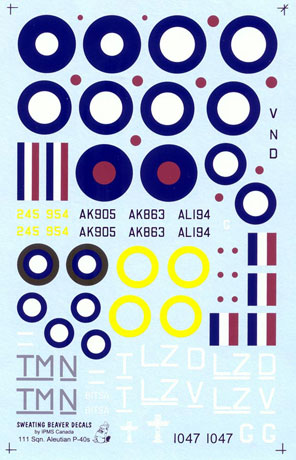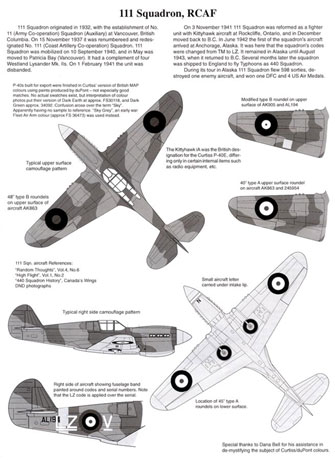S u m m a r y
|
| Catalogue
Number: |
N/A - Aleutian P-40s 111
Squadron RCAF |
| Scale: |
1/48 |
| Contents and Media: |
Waterslide decals |
| Price: |
USD$12.00 or
USD$6.00 for IPMS Canada Members available from IPMS Canada
website. |
| Review Type: |
FirstLook |
| Advantages: |
Great schemes and
interesting markings not typical of the P-40; sharp and clear
printing; perfect register; minimal carrier film; good
instructions (and informative too!) |
| Disadvantages: |
|
| Recommendation: |
Recommended |
Reviewed
by Rodger Kelly

Aeromaster's 1/48 scale Marauding Invaders Part I is available
online from Squadron.com
Sweating Beaver
decals – great name! – are produced by IPMS Canada.
Understandably, the subjects
of their decal sheets tend to concentrate on aircraft flown by the
RCAF. This sheet is no exception and it provides markings for five
P-40 Kittyhawks, all of which were flown by 111 Squadron in the
Aleutians during WWII. The Canadians were members of the British
Commonwealth during WWII and referred to their aircraft in the same
manner that the RAF did.
The Kittyhawk 1A was
equivalent to the P-40E with minor changes – check your references for
the exact changes.
First up is Kittyhawk 1A AK863
coded TM – N. The markings depict the aircraft when it
was based at Patricia Bay, Vancouver in May 1942. The aircraft is
painted in the DuPont paint Company’s version of dark earth, and dark
green over with sky grey under surfaces and spinner. The supplied
markings consist of:
·
 Medium
grey TM - N Squadron code letters with a further and
smaller N in black which was applied to engine cowling under the
radiator intake lip. This last marking is carried by each of the
aircraft on this sheet. Medium
grey TM - N Squadron code letters with a further and
smaller N in black which was applied to engine cowling under the
radiator intake lip. This last marking is carried by each of the
aircraft on this sheet.
·
A small white bar (which was carried
by all RCAF Kittyhawks) on the fuselage forward of the windscreen.
·
Type B Roundels on the upper surface
of the wings, type A on the under sides of the wing, and Type A1s for
the fuselage.
·
A wide fin flash for the vertical
stabilizer.
·
The serial number in black for the
fuselage.
Next is another Kittyhawk
1A. AK905, LD Z depicted as it appeared at Anchorage, Alaska in the
summer of 1942. AK905 was painted and marked in the same manner as
the previous aircraft with a few exceptions:
·
It carried pale blue fuselage band
and white squadron codes with the codes on the starboard side of the
fuselage only being underlined in the same manner as the previous
aircraft.
·
Had the yellow of its A1 fuselage
roundels over-painted in dark green,
·
Carried a “Thunderbird” emblem on the
port engine cowling.
·
Carried modified upper wing
roundels.
The third aircraft is another
Kittyhawk 1A, AL194 LZ – V that was also at Anchorage,
Alaska in the summer of 1942. This Kittyhawk was painted in the same
manner as the second aircraft The supplied markings are the same
except that it wore a larger Thunderbird emblem on the cowling and its
squadron codes were underlined on both sides of the fuselage.
The penultimate machine is a
little different from its squadron sisters in that it is a P-40K. It
still carried its U.S. serial number on the fin and rudder and wore a
single G squadron code letter. The markings depict it as it appeared
at Kodiak, Alaska in the summer of 1943. Its finish was also a little
unusual in that it was painted in olive drab over neutral grey with a
neutral grey spinner and fuselage band that was edged in thin blue
bands. Markings consist of:
·
The serial number in yellow.
·
A thin fin flash on the vertical
stabilizer.
·
White letter G squadron code.
·
Larger Type A roundels on the upper
wings and fuselage.
The last aircraft is another
Kittyhawk Mk 1A. The serial number is listed as 1047. The markings
depict it as it appeared at Kodiak, Alaska in the summer of 1943.
Finish is as for the second and third aircraft and it carries the
squadron letter T and the name “BITSA” under the cockpit. The
serial number is unusual and perhaps the aircraft was made up from a
combination of components from other aircraft, hence the name BITSA.
There is no mention as to who
printed the decals themselves. If I would hazard a guess I would say
they are very similar to, if not, Microscale. They are thin and have
minimal film surrounding each design. Everything is in perfect
register, sharp and clear.
 The
placement guide is A-4 in size, and provides left hand side profiles
of each option in the centre and black and white plan views of a
generic Kittyhawk ‘a upper surfaces and left hand side to show the
camouflage pattern. There are also two smaller drawings that show the
roundel placement for aircraft with the modified roundels as well as a
drawing showing the right hand side of LZ – V. As well
showing the placement of markings the placement guide also provides a
potted history of 111 Squadron and a brief discourse on DuPont paint
matches. The
placement guide is A-4 in size, and provides left hand side profiles
of each option in the centre and black and white plan views of a
generic Kittyhawk ‘a upper surfaces and left hand side to show the
camouflage pattern. There are also two smaller drawings that show the
roundel placement for aircraft with the modified roundels as well as a
drawing showing the right hand side of LZ – V. As well
showing the placement of markings the placement guide also provides a
potted history of 111 Squadron and a brief discourse on DuPont paint
matches.
The placement guide and decal
sheets (there are two of them) come packed in a clear plastic zip-loc
bag.
If you want to see what the
finished product looks like, go to the IPMS Canada web site at:
http://www.ipmscanada.com/111teaser.html where there are pics of
third option.
This is a nice package from
Sweating Beaver Decals that provides you with good quality decals and
a well-written, informative placement sheet at a reasonable price. It
gives you great markings and schemes that are not normally seen on
P-40s.
Recommended.
|
Home | What's
New | Features
| Gallery |
Reviews | Reference
| Forum
| Search